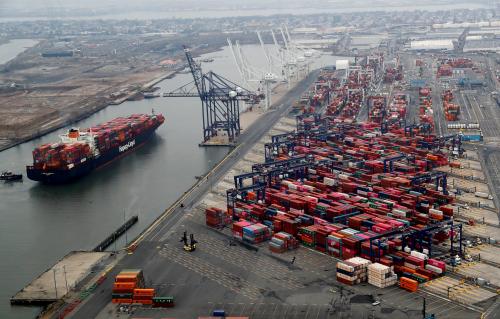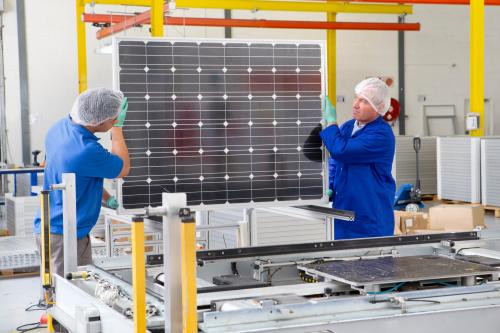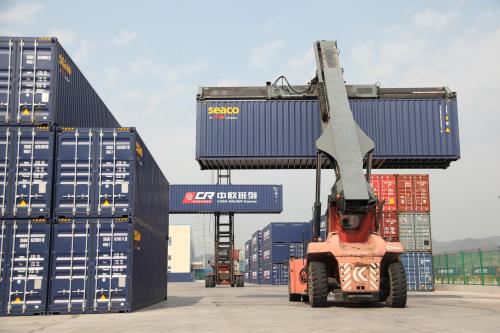On January 22, President Donald Trump imposed tariffs on solar panels in what he called an effort to “create jobs in America for Americans.” The move prompted widespread criticism from both solar and free trade advocates.
While the president argued that solar companies would “com[e] back strong” with the addition of “a lot of jobs,” the Solar Energy Industry Association, which represents the full spectrum of the U.S. solar industry, immediately expressed their objections. They estimated that the 30-percent tariff on imported solar cells and panels would cause the loss of 23,000 jobs in 2018, as well as the delay or cancellation of billions of dollars of investments in solar energy. Past experience from earlier trade disputes in the solar energy subsector support this view.
Solar tariffs are actually not new for the United States. In 2012, the Department of Commerce’s International Trade Commission (ITC) issued a duty on solar cells from China. Later, in 2015, the ITC imposed another penalty on solar cells imported from Taiwan. The ITC claimed in both cases that an industry in the U.S. was being materially injured by imports of solar cells and modules from these countries. American manufacturers were hurt by falling prices of solar products as a result of a flood of Chinese solar products. Since 2011, numerous manufacturers including Solyndra, Helios USA, and BP Solar closed their U.S. production facilities.
Yet the tariffs imposed did not really save U.S. solar cell and module manufacturing from international market pressures. At this point, there are only 14 solar cell/module manufacturers in the U.S. A majority of solar cell and modules are now produced in Asia, with China as the leading (and most cost competitive) producer worldwide. The impact of American tariffs was insignificant partially because Chinese manufacturers could simply move their production to other Asian countries to avoid the tariffs. The tariffs on Taiwanese cells attempted to close this loophole, but the manufacturers still had many other options (such as Vietnam).
The new Trump solar tariff closes this potential loophole by covering all imports. However, it will not likely lead to a dramatic boost to domestic cell and module manufacturing, for several reasons. First, the competitiveness gap between the most well-positioned players—Chinese manufacturers—and U.S. manufacturers seems too significant to be closed via the new tariff. According to the International Renewable Energy Agency, the average solar module price in China was 0.43 cents per watt in 2016, while it was 0.61 cents per watt in California, which was one of the highest averages among major markets. Therefore, despite its other flaws, the new tariff may simply be too low to drive existing U.S. manufacturers to greatly expand their capacity and thus to protect jobs. Second, although some foreign manufacturers have responded positively, the four-year duration of the tariff may limit its ability to attract significant investments of foreign manufacturers to build plants in the U.S.
In addition to lasting only four years, the tariff declines every year to 25 percent in 2019—20 percent in 2020, and 15 percent in 2021, its final year. Given that building a cell manufacturing plant takes up to two years, it is unlikely that a manufacturer would invest in building a new plant to take advantage of a modest level of tariff for a couple of years. Moreover, the risk that the tariff can be challenged by other countries through the World Trade Organization compounds concerns for potential investors.
The upshot is that the tariff will likely have only a marginal effect if any impact on supporting solar manufacturing jobs in the U.S. In this light, by far the more important impact of the tariff is its negative effect on the broader solar industry, including solar installation.
In recent years, U.S. solar installation has grown rapidly, driven by the dramatically falling cost of solar products. In 2016, solar installation reached approximately 17 times of the installation in 2010. The new tariff would slow this rise. According to GTM Research, the tariff would result in a net reduction of 11 percent in U.S. solar installations from 2018 to 2022—reducing installations from an estimated 68.9 gigawatts to 61.3 gigawatts over the next five years. The market analysis firm IHS Markit estimates a similar 9 to 10 percent reduction over the next four years.
This slower growth of low-carbon energy in one of the largest emitter countries is a critical concern, as it both reduces job growth and creates obstacles to the rapid pace of clean energy deployment needed to address climate and clean air challenges. Although Trump argues that this is designed to protect solar manufacturing jobs, the tariff is likely to help spur jobs in competing industries, like coal, whose economic viability has been threatened by the advent of rapidly declining costs for natural gas and solar energy.
A slowdown in the installation rate of solar panels would negatively affect American jobs. So-called “downstream solar”—installation, project development, and sales and distribution—grew dramatically in recent years. According to the National Solar Jobs Census 2017, installation now accounts for 51.7 percent of solar-related jobs in the U.S., while manufacturing accounts for only 14.7 percent. Even within solar manufacturing, only a small portion of jobs are in the manufacturing of cells and modules—most American solar manufacturing jobs are in equipment manufacturing such as racking systems, inverters, and solar trackers. Given the composition of the U.S. solar industry, the loss of American solar jobs would be much bigger than any new jobs created by the tariff.
Retaliatory actions in response to the solar tariff are another possibility. Previously, the imposition of tariffs on Chinese solar products instigated a retaliatory ban of U.S.-produced polysilicon in China. The recent rise in international trade of renewable energy products has led many governments to adopt protectionist policies for their own industries, which has generated trade disputes between countries. As of February 7, 13 dispute cases have been submitted to the World Trade Organization related to protectionist policies for renewable energy industry. These disputes have increased risks and uncertainty in the solar market, which discourages investment. The new solar tariff makes this protectionist path more likely.
The overall impact of solar tariffs, then, is best assessed from a broad perspective not limited to just manufacturing. First, across the entire solar value chain, solar cell and module manufacturing is a small part of the U.S. solar industry. For the many jobs created in the other parts of the value chain, the tariff is a hindrance. Moreover, even for U.S. solar manufacturing, the impact of the tariff may not be significant given the already high competitiveness gap compared to other global players. From this perspective, the solar tariff may be on balance harmful for the U.S. economy. Second, the rationale of solar energy is not only economic, but also environmental. Speeding up the installation of renewable energy facilities is as important as boosting U.S. manufacture of solar panels as the U.S. and other countries strive to get on a low-carbon growth path. Finally, global politics cannot be ignored. The possibility of trade retaliation could affect not only the solar market, but also other industries.
A solar tariff is about not only domestic solar manufacturing, but also the entire solar industry, a low-carbon economy, and the global solar market. From this perspective, building a robust, competitive, and innovative business environment for the solar industry can pay more dividends than protecting a small part of the industry.
The focus of policy to support jobs for the solar industry should be on stable, longer-term, and predictable signals to the market. This will encourage large-scale and long-term investments, which the solar tariff is unlikely to bring about.






Commentary
What past experience tells us about the impact of new American solar tariffs
February 9, 2018